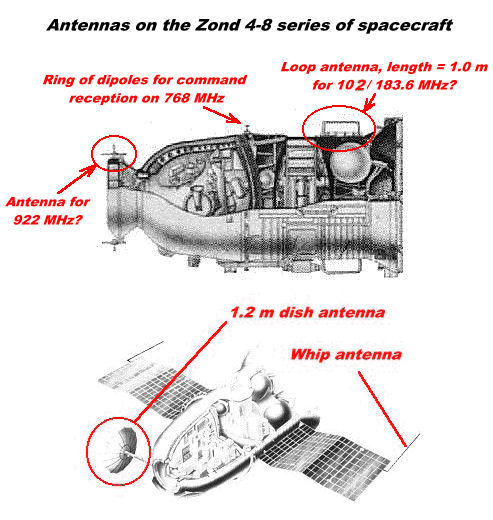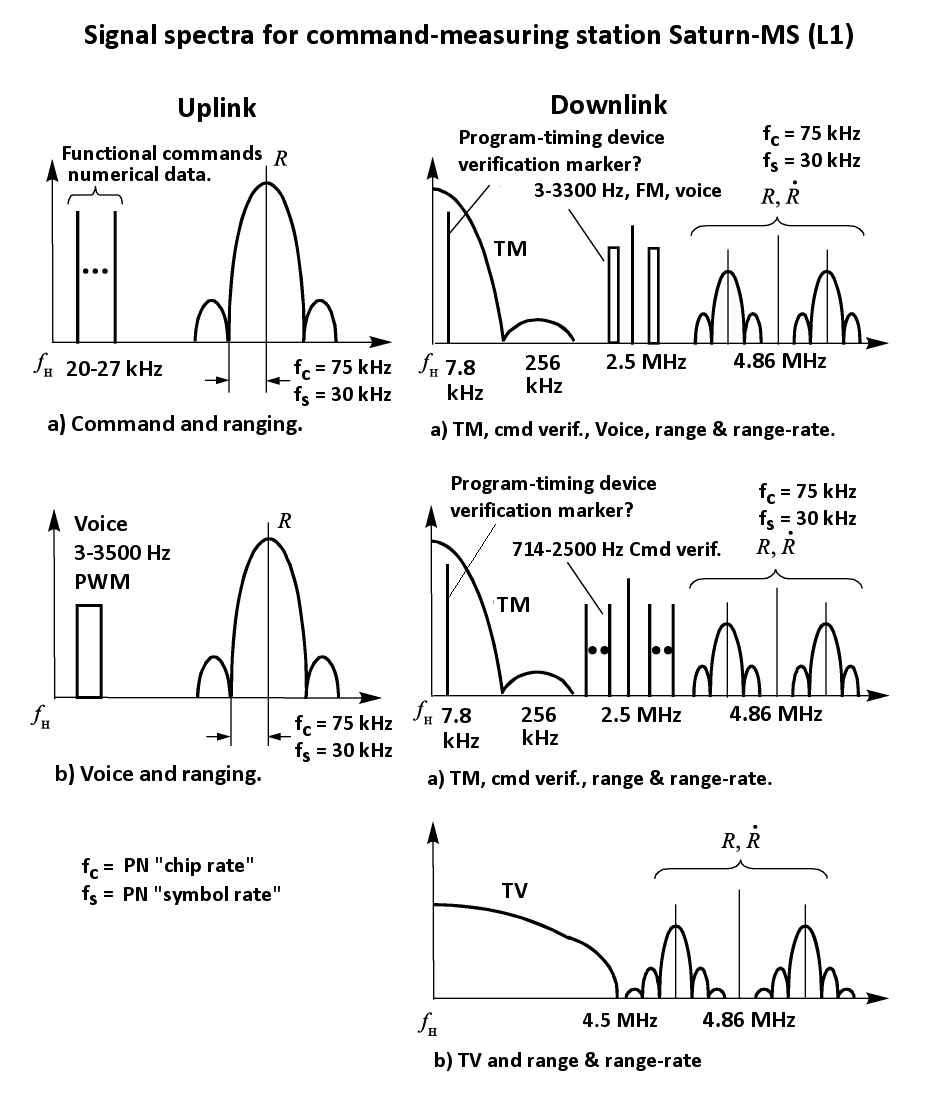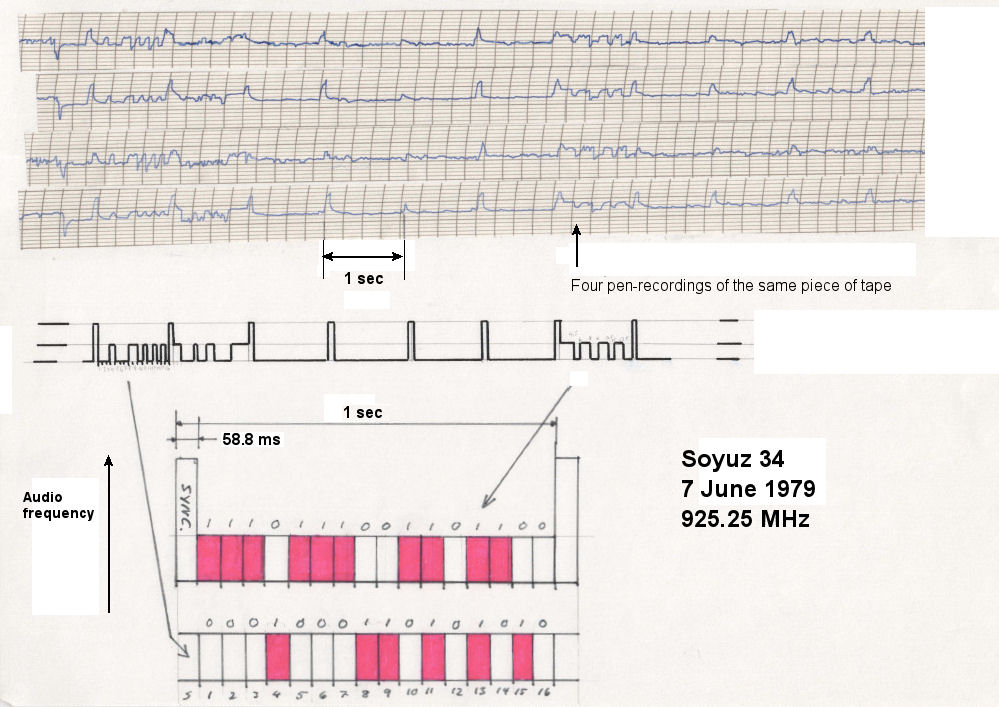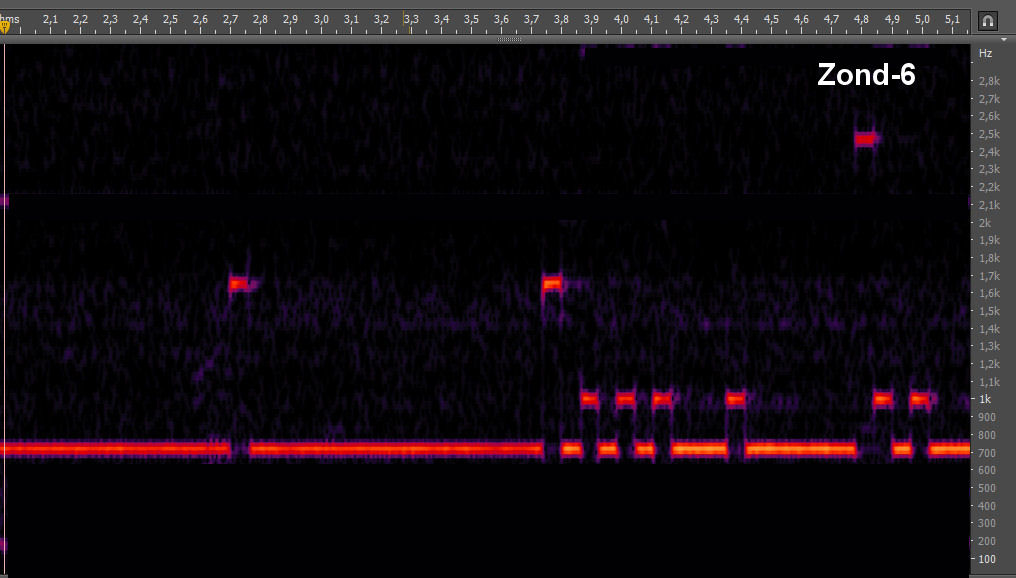 Zond and Soyuz share the
same basic design, but there are differences between the craft. The differences
in outward appearance between Soyuz and Zond that relate to radio systems can be
summarized as follows:
Zond and Soyuz share the
same basic design, but there are differences between the craft. The differences
in outward appearance between Soyuz and Zond that relate to radio systems can be
summarized as follows:
Sven Grahn
 Zond and Soyuz share the
same basic design, but there are differences between the craft. The differences
in outward appearance between Soyuz and Zond that relate to radio systems can be
summarized as follows:
Zond and Soyuz share the
same basic design, but there are differences between the craft. The differences
in outward appearance between Soyuz and Zond that relate to radio systems can be
summarized as follows:
Very little information used to be available in the public domain about frequencies used by the Zond system. In the past only informal information was available to support the assumption that a 922.76 MHz downlink was used. However, a recent Russian publication (1) provides plenty of detail of the radio system. This source indicates that the basic Saturn-MS ground stations were also used for early Soyuz and Salyut missions and gives the uplink as "770 MHz" and the downlink as "920 MHz", which confirms the early guesses as to frequency. The sketch below from (1) (my translations of the captions) shows the various signalling modes on this basic link. Interestingly, the command-verication signals have been heard from early Soyuz, Progress and Salyut craft around 925.24-925.25 MHz, which is indeed 2.5 MHz from the center frequency, just as indicated below. Listen to the command-verification signal from Soyuz-34 in June 1979 here .

The sketch above from (1) (my translations of the captions) shows the various signalling modes on this basic link. Interestingly, the command-verication signals have been heard from early Soyuz, Progress and Salyut craft around 925.24-925.25 MHz, which is indeed 2.5 MHz from the center frequency, just as indicated below. Listen to the command-verification signal from Soyuz-34 in June 1979 here, the first time I detected this type of signal. A pen-recording of these signals fed through a frequency meter is shown below.

Below is an audio spectrogram of this type of signals. In this case from Progress-11 on 925.25 MHz on 28 September 1980 at 2118 UT. The base audio tone is at about 750 Hz. Data bit are located at about 1050 Hz while the 1-second sync tones appear at 1750 Hz, it seems.

In 2018 Jodrell Bank published a recording of signals from Zond-6 in 1968. The sound file is available for download and I have listened to the part that is not voice (re-broadcast from the uplink) and made an audio spectrogram of a short piece of the signal. It it reproduced below. The base tone is just above 700 Hz. There are sync pulse tones at about 1600 Hz and they are transmitted every second just as from the Soyuz and Progress command verification link. Bit values are transmitted at about 1000 Hz. But the Zond-6 signal spectrum also contains pulses at 2500 Hz at the end of each 1-sec interval in case there is daat transmitted in the interval. This is a major difference beween the Zond and Soyuz/Progress signals. A little tabel can be put togeher to show the differences/similarities between the signals on 925.25 MHz. The Zond-6 values agree well with the numbers in the figure from (1 ). The same 2.5 MHz subcarrier is also used for voice which is evident from the Jodrell Bank recording where the comamnd verification tones are replaced by voice uplinked from the ground.
| Tone | Soyuz/Progress | Zond-6 |
| Base |
750 |
710 |
| Bit value |
1050 |
1000 |
| 1-sec sync |
1750 |
1600 |
| "Extra sync" |
- |
2500 |

Informal hints from personal acquaintancies mention 183 MHz as a downlink. The analysis of the pictures of Zond seem to support the use of the old 183/102 MHz TT&C systems as a back-up. However, the whip antennas on the solar panel tips are difficult to tie to a specific downlink frequency. It is difficult to envisage that 76-80 MHz was used in deep space, since the "Tral" telemetry system that used this frequency range was a wideband system operating in low earth orbit. It seems more reasonable to assume that the whips were used for a frequency near 40 MHz, perhaps the same type of simple telemetry that was transmitted by the early Luna probes on 39.986 MHz.
It seems reasonable to conclude that the main telemetry, command and tracking link used by Zond 4-8 was the 922.76 MHz downlink with the uplink at 768 MHz. In addition a back-up system using omni antennas seems to have operated on the old Soviet deep space TT&C system that used 183.6 MHz as a downlink and 102 MHz as an uplink. Perhaps 40 MHz was used for very low rate housekeeping telemetry.
According to (1) the LOK vehicle used the same frequencies as L1, i.e. 922/768 MHz and also a VHF uplink. Here is a translation of a sentence from Molotov's book:
"... The meter-band (106 MHz) was used for a "request signal" in a noncoherent channel, while the working frequency of the reply channel was shifted by 6.5 MHz with respect to the frequency of the coherent channel ..."
By "the coherent channel" Molotov probably means 922 MHz. In all probability this non-coherent uplink on 106 MHz was a back-up command link. It is not easy to find an antenna for this frequency on sketches of LOK. Perhaps the little rod in the picture below is this antenna. In other sketches there appears to be at least two such antennas.

![]()